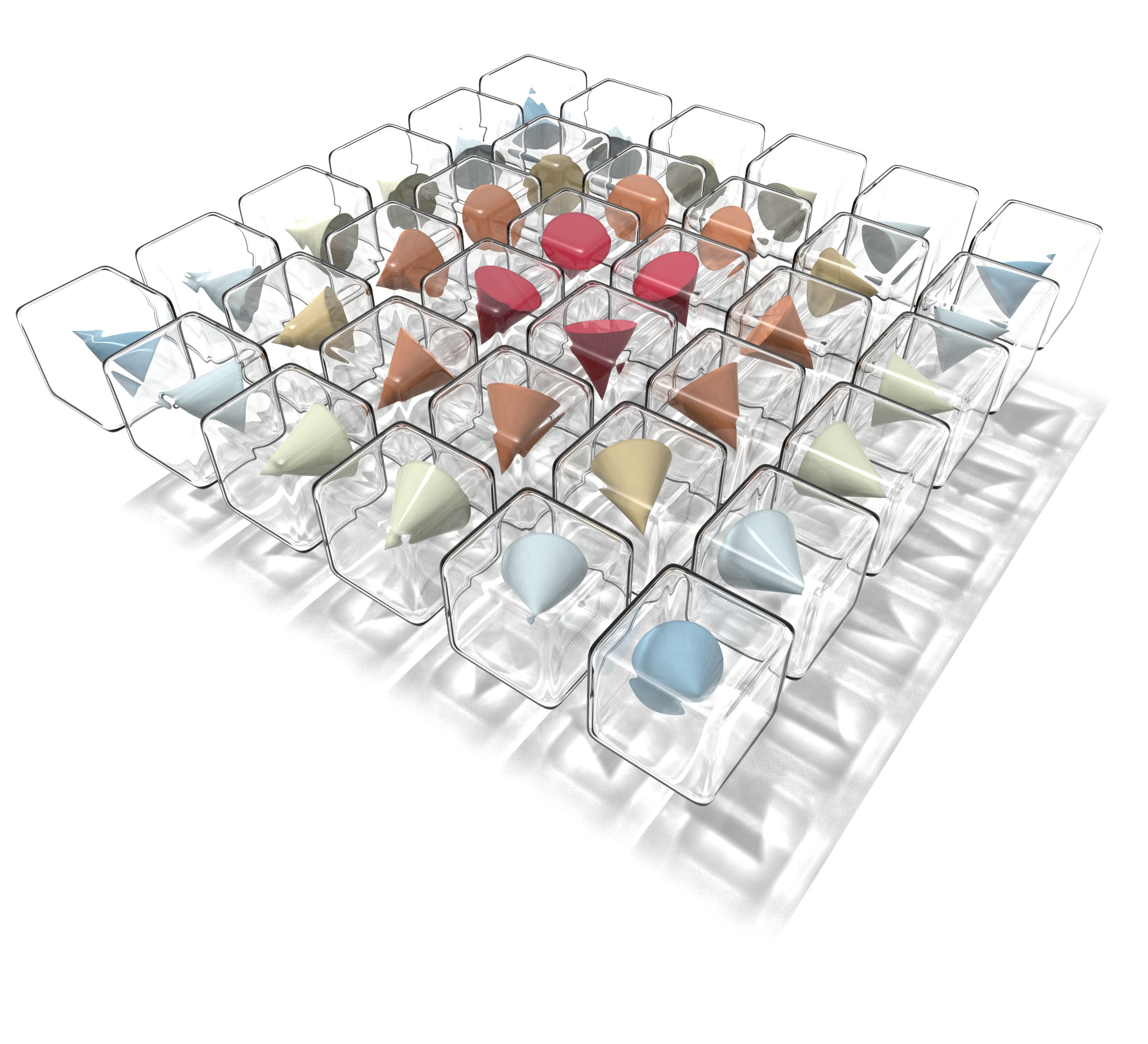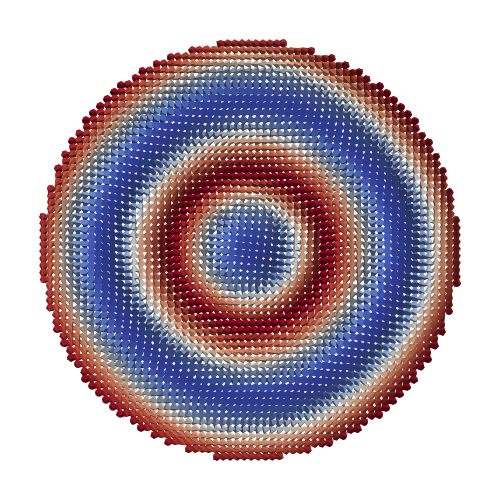Fidimag solves finite-difference micromagnetic problems and supports atomistic simulations, using Python interface. The interface to both types of simulation is similar.
- Offers LLG and LLG with spin torque terms (Zhang-Li and Sloncewski)
- Calculations using the Nudged-Elastic-Band method to compute energy barriers.
- Exchange, Zeeman, Demagnetising, Uniaxial Anisotropy energy classes.
- Parallelised using OpenMP.
- Easily extensible to add new features.
- Cubic and Hexagonal Meshes in atomistic simulations.
- Open-source under the 2-clause BSD Licence.
Here we show how to relax a nanodisk system from an initial state. We have many more examples in the documentation!
import fidimag
from fidimag.common import CuboidMesh
from fidimag.micro import Sim, UniformExchange, Demag, DMI, UniaxialAnisotropy
mesh = CuboidMesh(nx=60, ny=60, nz=1, dx=2.0, dy=2.0, dz=2.0, unit_length=1e-9)
def Ms_init(position):
"""
Set where the system has magnetic material
Form a nanodisk shape
"""
Ms = 8.6e5
x, y, z = position
if (x - 60)**2 + (y - 60)**2 < 60**2:
return Ms
else:
return 0
def m_init(position):
"""
Approximate skyrmion profile
"""
x, y, z = position
if (x - 60)**2 + (y - 60)**2 < 40**2:
return (0, 0, 1)
else:
return (0, 0, -1)
sim = Sim(mesh, name='target_skyrmion')
sim.set_Ms(Ms_init)
sim.set_m(m_init)
sim.add(Demag())
sim.add(UniformExchange(A=1e-11))
sim.add(DMI(D=3e-3))
sim.add(UniaxialAnisotropy(Ku=4e5, axis=(0, 0, 1)))
sim.relax()
sim.save_vtk()The results can be straightforwardly visualised from the outputted VTK files using programs such as Paraview:
The code is developed by Weiwei Wang, Marc-Antonio Bisotti, David Cortes, Thomas Kluyver, Mark Vousden, Ryan Pepper, Oliver Laslett, Rebecca Carey, and Hans Fangohr at the University of Southampton.
This is an early experimental version; contributions and pull requests to both the code and documentation are welcome. If you use Fidimag, please cite as:
Bisotti, M.-A., Cortés-Ortuño, D., Pepper, R., Wang, W., Beg, M., Kluyver, T. and Fangohr, H., 2018. Fidimag – A Finite Difference Atomistic and Micromagnetic Simulation Package. Journal of Open Research Software, 6(1), p.22. DOI: http://doi.org/10.5334/jors.223
The following publications, in reverse chronological order, have used Fidimag:
[1] Proposal for a micromagnetic standard problem for materials with Dzyaloshinskii–Moriya interaction, D. C-Ortuño, M. Beg2, V. Nehruji3, L. Breth1, R. Pepper, T. Kluyver, G. Downing, T. Hesjedal, P. Hatton3, T. Lancaster, R. Hertel5, O. Hovorka and H. Fangohr, New Journal of Physics, Volume 20 (2018)
[2] Driving chiral domain walls in antiferromagnets using rotating magnetic fields K.Pan, L.Xing, H.Y.Yuan, and W.Wang, Physical Review B 97, 184418 (2018).
[3] Fidimag - A Finite Difference Atomistic and Micromagnetic Simulation Package, Bisotti, M.-A., Cortés-Ortuño, D., Pepper, R., Wang, W., Beg, M., Kluyver, T. and Fangohr, H., Journal of Open Research Software, 6(1), p.22. (2018)
[4] Thermal stability and topological protection of skyrmions in nanotracks, D. Cortés-Ortuño, W. Wang, M. Beg, R.A. Pepper, M-A. Bisotti, R. Carey, M. Vousden, T. Kluyver, O. Hovorka & H. Fangohr, Scientific Reports 7, 4060 (2017)
[5] Current-induced instability of domain walls in cylindrical nanowires, W. Wang, Z. Zhang, R.A. Pepper, C. Mu, Y. Zhou & Hans Fangohr, Journal of Physics: Condensed Matter, 30, 1 (2017)
[6] Magnonic analog of relativistic Zitterbewegung in an antiferromagnetic spin chain, W. Wang, C. Gu, Y. Zhou & H. Fangohr, Phys. Rev. B 96 024430 (2017)
[7] Driving magnetic skyrmions with microwave fields W. Wang, M. Beg, B. Zhang, W. Kuch, and H. Fangohr, Phys. Rev. B 92, 020403 (2015).
[8] Microwave-induced dynamic switching of magnetic skyrmion cores in nanodots B. Zhang, W. Wang, M. Beg, H. Fangohr, and W. Kuch, Applied Physics Letters 106, 102401 (2015).
[9] Magnon-Driven Domain-Wall Motion with the Dzyaloshinskii-Moriya Interaction W. Wang, M. Albert, M. Beg, M-A. Bisotti, D. Chernyshenko, D. Cortés-Ortuño, I. Hawke & H. Fangohr, Phys. Rev. Lett. 114, 087203 (2015)
We acknowledge financial support from EPSRC’s Centre for Doctoral Training in Next Generation Computational Modelling (EP/L015382/1), EPSRC’s Doctoral Training Centre in Complex System Simulation (EP/G03690X/1), EPSRC Programme grant on Skyrmionics (EP/N032128/1) and OpenDreamKitHorizon 2020 European Research Infrastructure project (676541).


